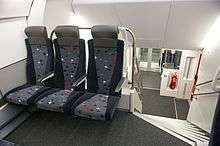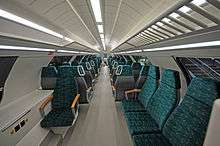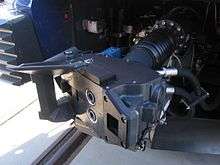Stadler KISS
The Stadler KISS is a family of bilevel electric multiple unit commuter trains developed and built since 2008 by Stadler Rail of Switzerland. As of 2016, 242 KISS trainsets comprising 1,145 cars have been sold to operators in nine countries.[3]
| Stadler KISS | |
|---|---|
.jpg) In service with the Zürich S-Bahn | |
| In service | 2011– |
| Manufacturer | Stadler Rail |
| Constructed | 2008– |
| Entered service | 2011 |
| Formation | Up to 6 cars per train[1] |
| Fleet numbers | RABe 511 |
| Capacity | First class: 112 Second class: 414 |
| Operator(s) | Swiss Federal Railways and others |
| Specifications | |
| Car body construction | Aluminium[1] |
| Car length | 25 m (82 ft 1⁄4 in)[1] |
| Width | 2.8 m (9 ft 2 1⁄4 in)[1] (2.92 m for Sweden[2]) |
| Height | 4.595 m (15 ft 7⁄8 in)[1] (4.7 m for Sweden[2]) |
| Floor height | 440 mm (17 in)[1] |
| Entry | 570 mm (22 in)[1] |
| Maximum speed | 160 km/h (99 mph)[1] |
| Weight | 296 t (291 long tons; 326 short tons)[1] |
| Power output | 6,000 kW (8,000 hp) Max 4,000 kW (5,400 hp) Cont |
| Acceleration | 1.1 m/s2 (3.6 ft/s2)[1] |
| Power supply | For HVAC |
| Electric system(s) | 15 kV AC 16.7 Hz overhead catenary[1] 3 kV DC |
| Current collection method | Pantograph |
| Track gauge | 1,435 mm (4 ft 8 1⁄2 in) standard gauge[1] 1,520 mm (4 ft 11 27⁄32 in) Russian gauge |
Name
In the early stages of development, the KISS was known as the Stadler DOSTO. This name was derived from the German word Doppelstock, meaning "double decker".
Since September 2010, Stadler refers to the train as "KISS", an acronym for "Komfortabler Innovativer Spurtstarker S-Bahn-Zug", meaning "comfortable, innovative, sprint-capable suburban train".[4] Transitio AB in Sweden uses the name "DOSTO" because "kiss" means "pee" in Swedish.
In Swiss Federal Railways service, the train is classified as RABe 511. For the Eastern European market, it is branded "Eurasia".
Features
The KISS vehicles are the third generation of vehicles for the S-Bahn Zürich. Compared to previous generations, they are characterized mainly by a higher number of standing passengers per car, in part because the longer trains have proportionately fewer cabs. Also, 15 cm width was won by placing the HVAC channels under the ceiling instead of the side panel. The headroom is still two meters, because friction stir welded floor panels made from aluminium extrusions are used. The number of seats, however, is slightly lower than in the previous models. Like in the KISS's predecessors, low-floor entrances, vehicle air conditioning and vacuum toilets (two, including one wheelchair accessible) are available. There are also two multi-functional areas with storage space for strollers, bicycles and the like.
The six-car train set consists of two power cars and four trailers. In the power heads, all axles are powered. The "Eurasia" version for the Russian gauge railways, in a six and four-car formation, has no power heads.
The train's power plant is capable of delivering brief bursts (several minutes) of "sprint" power, over 6,000 kilowatts, enabling it to overtake other trains on short express tracks.[5]
Customers
| Year of order | Year of traffic | Customer | Country | No. of trainsets | Notes |
|---|---|---|---|---|---|
| 2008 2015 | 2012 2016 | Swiss Federal Railways | Switzerland | 69 (50+19) | For use in the Zürich S-Bahn[6][7] |
| 2010 | 2012 | BLS AG | Switzerland | 28 | For use in the Bern S-Bahn[8] |
| 2010 | 2012 | Ostdeutsche Eisenbahn | Germany | 16 | For regional lines in Berlin/Brandenburg[9] |
| 2010 | 2011 | WESTbahn (later Deutsche Bahn) | Austria | 17 | For service between Vienna and Salzburg.[9] Sold to Deutsche Bahn in 2020 for use as IC2 intercity trains on the Dresden-Berlin-Rostock line.[10] |
| 2010 | 2012 | Swiss Federal Railways | Switzerland | 24 | For use on regional express lines[11][12] |
| 2010 | 2014 | CFL | Luxembourg | 19 | For service between Luxembourg and Koblenz, Luxembourg and Trier and Luxembourg and Düsseldorf [13] |
| 2013 | 2015 | Westfalenbahn | Germany | 13 | For regional lines in North Rhine-Westphalia and Lower Saxony[14] |
| 2015 | 2017 | WESTbahn | Austria | 10 | For service between Vienna and Salzburg[15] |
| 2013 | 2016 | Aeroexpress | Russia | 11[16] | For the Moscow airport shuttle service[17][16] as ESh2 "Eurasia" |
| 2015 | Azerbaijan Railways | Azerbaijan | 5[18][16] | Labelled as EŞ2 "Eurasia"[16] | |
| 2016 | Georgian Railways | Georgia | 4[16] | Labelled as GRS "Eurasia"[16] | |
| 2016 | 2019 | Mälardalstrafik (leased from Transitio) | Sweden | 33 | For use in the Mälaren Valley. Max speed 200 km/h. Designated as ER1.[19] |
| 2016 | 2022 (planned) | Caltrain (JPBX) | USA | 19 | Initial order of 96 cars (16 6-car set) with an option for additional 96 cars;[20] increased to 133 cars (19 7-car sets) in 2019, with options for 59 cars remaining |
| 2017 | 2019 | Kollektivtrafikförvaltningen UL (leased from Transitio) | Sweden | 8 | For the "Upptåget" service between Uppsala-Gävle.[21] |
| 2017 | 15 March 2020 | MÁV-Start | Hungary | 40 (19+21) | 6-section variants. The first vehicle may enter service in the second quarter of 2020, the last of which will begin in early 2021[22] |
| 2018 | 2020 (planned)[23] | Slovenske železnice | Slovenia | 10[23] | 3-section variants[23] |
Gallery
 Car being loaded onto a barge for transport, ESh2 Eurasia
Car being loaded onto a barge for transport, ESh2 Eurasia.jpg) Cockpit, SBB RABe 511
Cockpit, SBB RABe 511 Wheelchair-accessible toilet, SBB RABe 511
Wheelchair-accessible toilet, SBB RABe 511.jpg) Boarding area, WESTbahn 4010
Boarding area, WESTbahn 4010 Boarding area, SBB RABe 511
Boarding area, SBB RABe 511 Boarding area and stairs, ESh2 Eurasia
Boarding area and stairs, ESh2 Eurasia First class interior, SBB RABe 511
First class interior, SBB RABe 511 First class interior, WESTbahn 4010
First class interior, WESTbahn 4010- Second class interior, CFL Class 2300
 Second class interior, ODEG
Second class interior, ODEG SBB RABe 511 coupler
SBB RABe 511 coupler- Schwab coupler type FK-15-10
 Trainset arriving at Örbyhus station, UL Dosto/ER1
Trainset arriving at Örbyhus station, UL Dosto/ER1
References
- "Electric Double-Deck train DOSTO" (PDF). Train data sheet. Stadler Rail. Archived from the original (PDF) on 2010-09-20. Retrieved 2008-12-17 and 2010-11-06. Check date values in:
|access-date=(help) - DOSTO MÄLARTÅG
- Editor-in-Chief, William C. Vantuono (16 August 2016). "For Caltrain, 16 KISSes from Stadler (but no FLIRTs)". Railway Age. Retrieved 17 August 2016.CS1 maint: extra text: authors list (link)
- Stadler press release Archived 2011-04-27 at the Wayback Machine, 22 September 2010
- , February 2012
- "Neues Rollmaterial für 1,5 Milliarden". Tages-Anzeiger. 30 June 2008. Archived from the original on 7 July 2011. Retrieved 2008-12-17.
- "Zürich, Waadt und Zug: SBB kauft weitere Züge für S-Bahnverkehr bei STADLER". Bahnonline.ch. 2015-06-04. Retrieved 2017-09-21.
- "BLS buys double-deckers for Bern S-Bahn". Railway Gazette. 30 March 2010.
- Bloch, Urs (23 September 2016). "Stadler Rail präsentiert den neuen Doppelstockzug erstmals im Ausland: Auf den Flirt folgt ein Kiss". Neue Zürcher Zeitung (in German). Retrieved 17 August 2016.
- "Stadler KISS Trains to Operate DB IC2 Services". Railway-News. 2020-02-05. Retrieved 2020-02-22.
- SBB bestellt weitere 24 RegioExpress-Doppelstockzüge. Press release of SBB. Retrieved on 17. April 2010.
- "Option im Umfang von 350 Millionen Franken bei der Firma Stadler eingelöst: Weitere Doppelstockzüge für die SBB". 15 April 2010 – via NZZ.
- "A Kiss for Luxembourg - News - Stadler" (Press release). Stadler Rail. 12 October 2010. Archived from the original on 2010-10-15. Retrieved 8 January 2011.
- "Westfalenbahn: Elektrischer Doppelstocktriebzug KISS". Retrieved 9 April 2020.
- Reidinger, Erwin (7 July 2016). "Stadler presents first Kiss 2 EMU to Westbahn". International Railway Journal. Retrieved 17 August 2016.
- "ESh2 (rolling stock list and image gallery)". TrainPix.
- UK, DVV Media. "Stadler wins Moscow double-deck train order".
- UK, DVV Media. "Stadler to supply double-deck EMUs to Azerbaijan".
- "DOSTO Mälartåg" (PDF). Stadler Rail. Retrieved 17 August 2018.
- http://www.progressiverailroading.com/passenger_rail/news/Caltrain-inks-contracts-with-Balfour-Beatty-Stadler-for-electrification-project
- "Dubbeldäckare ska rädda Upptåget". Upsala Nya Tidning (in Swedish). 2017-05-15. Retrieved 2017-05-15.
- http://fonodo.reblog.hu/ket-ev-mulva-keszul-el-dunakeszin-az-elso-emeletes-magyar-vonat
- "Slovenian Railways orders 26 multiple units from Stadler". International Rail Journal. 18 April 2018. Retrieved 23 April 2018.
External links
| Wikimedia Commons has media related to Stadler KISS. |